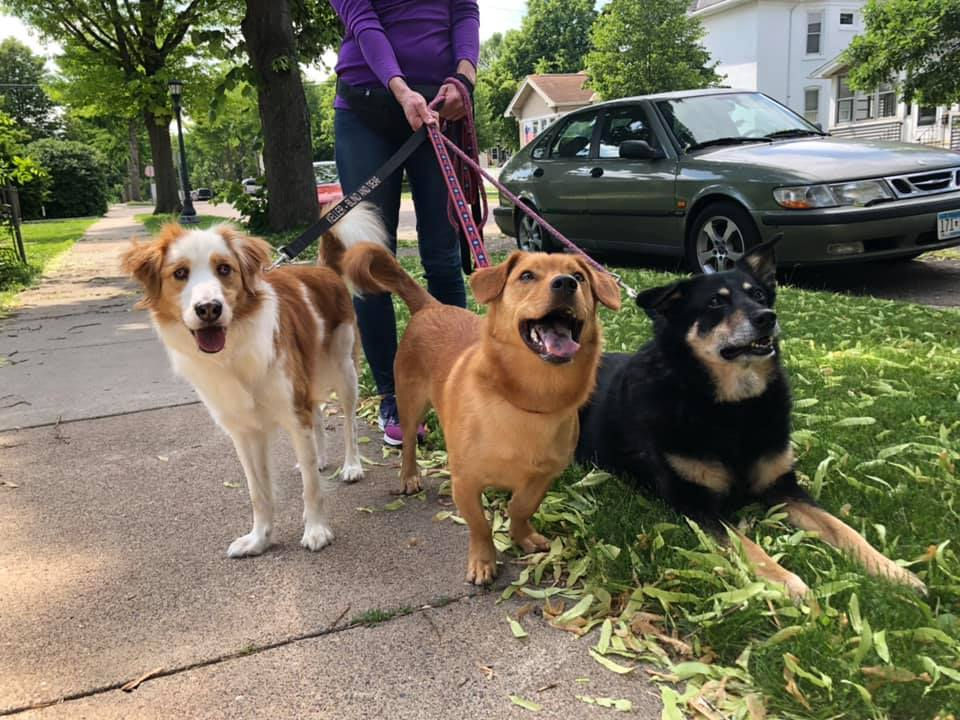21 Tricks for Managing Multi-Dog Walks
- Breanna Pederson

- Oct 3, 2023
- 4 min read
If you're a multi-dog owner, you know the joy and challenges that come with it. Walking multiple dogs can be a delightful experience when done right, but it can also turn chaotic without proper management. In this guide, we'll explore Tricks for Managing Multi-Dog Walks that will transform your outings into harmonious adventures for both you and your beloved pets.
Introduction
Walking multiple dogs can be a rewarding experience, allowing your furry friends to socialize, exercise, and explore the world together. However, it can also be overwhelming if not properly managed. To make your multi-dog walks enjoyable and stress-free, we've compiled a comprehensive guide filled with expert tips, tricks, and insights. Whether you're a seasoned multi-dog owner or a newbie, you'll find valuable information here to enhance your walks and create memorable bonding moments.
Tricks for Managing Multi-Dog Walks
In this section, we will delve into practical strategies and techniques to ensure smooth multi-dog walks.
1. Establish a Hierarchy
Creating a clear hierarchy among your dogs is crucial. Ensure that each dog understands their position in the pack. This will reduce tension and conflicts during walks.
2. Leash Training
Proper leash training is essential. Teach your dogs to walk calmly on a leash, avoiding tangles and pulling. Use positive reinforcement techniques for best results.
3. Consistent Commands
Consistency is key. Use consistent commands for behaviors like "sit," "stay," and "heel." This will make it easier to manage multiple dogs simultaneously.
4. Individual Walks
While group walks are fun, individual walks are equally important. Each dog deserves one-on-one time with you. This helps in strengthening the bond and addressing specific needs.
5. Be Mindful of Energy Levels
Understand your dogs' energy levels. Plan walks according to their needs. High-energy dogs may require longer walks, while older dogs might prefer shorter ones.
6. Use of Long Lines
Long lines or leashes give dogs more freedom while ensuring control. They are especially useful in open spaces like parks.
7. Maintain a Steady Pace
Keep a steady pace during your walks. Avoid sudden changes in direction or speed to prevent tripping and confusion among your dogs.
8. Socialization
Multi-dog walks are an excellent opportunity for socialization. Introduce your dogs to new experiences, people, and other animals in a controlled environment.
9. Carry Essentials
Always carry essentials like water, waste bags, and first-aid supplies. Being prepared ensures the safety and comfort of your dogs.
10. Rotate Leaders
Let different dogs take the lead during walks. This can help establish a sense of fairness and reduce competition.
11. Handle Encounters Calmly
When encountering other dogs or distractions, stay calm and composed. Your dogs will mirror your emotions, so maintain a relaxed demeanor.
12. Use Treats Sparingly
While treats are excellent for rewarding good behavior, use them sparingly to avoid overindulgence or weight issues.
13. Supervise Play
If your dogs engage in play during walks, supervise them closely to ensure it remains friendly and doesn't escalate into aggression.
14. Respect Others
Be considerate of other walkers, joggers, and pet owners you encounter. Ensure your dogs don't disrupt their experience.
15. Practice Recall
Teach your dogs a reliable recall command. This is essential for bringing them back to you when needed, especially in open areas.
16. Address Behavioral Issues
If you encounter behavioral issues during walks, such as leash aggression or fearfulness, seek professional training assistance.
17. Vary Routes
Keep walks interesting by varying your routes. Exploring new places can stimulate your dogs' senses and keep them engaged.
18. Plan for Rest
Allow your dogs to rest during long walks. Bring portable resting spots like foldable mats to ensure their comfort.
19. Stay Attentive
Stay attentive to your dogs' body language. This helps you anticipate their needs and react accordingly.
20. Safety First
Prioritize safety above all else. Always use well-fitted collars and harnesses, and ensure your dogs are up-to-date on vaccinations.
21. Be Patient
Patience is key when managing multiple dogs. Give them time to adjust to the routine and each other's presence.
FAQs
Q: Can I walk my multi-dog pack without leashes?
A: Yes, but only in designated leash-free areas where it's safe and permitted. In other areas, using leashes is essential for everyone's safety.
Q: How do I handle two dogs that don't get along during walks?
A: If two dogs don't get along, consider separate walks or consulting a professional dog trainer for guidance.
Q: Is it possible to train multiple dogs at once?
A: Yes, it's possible to train multiple dogs simultaneously, but it requires patience and consistency. Consider group obedience classes if needed.
Q: What should I do if one of my dogs gets distracted easily during walks?
A: If a dog is easily distracted, work on their focus through training exercises and positive reinforcement.
Q: How can I prevent my dogs from pulling on the leash?
A: To prevent leash pulling, use techniques like the "stop and go" method and reward your dogs for walking calmly beside you.
Q: Are there any special considerations for walking senior dogs in a multi-dog pack?
A: Yes, senior dogs may have different exercise needs. Consult your veterinarian for guidance on suitable activities.
Conclusion
Mastering the art of managing multi-dog walks requires patience, consistency, and a deep understanding of your furry companions. By implementing the tricks and tips provided in this guide, you can turn your walks into enjoyable adventures that strengthen the bond between you and your dogs. Remember, every dog is unique, so tailor your approach to their individual needs. Happy walking!





Comments